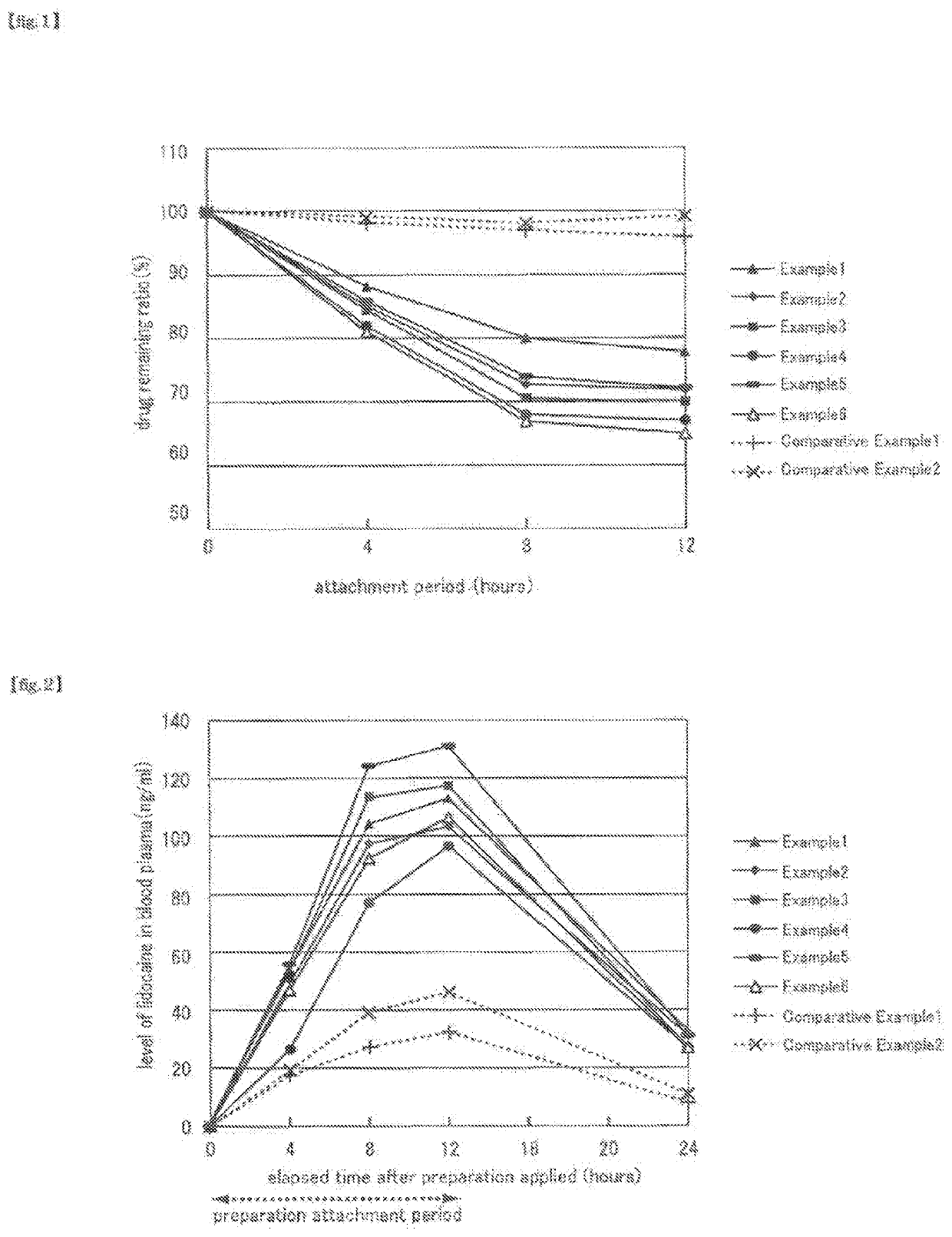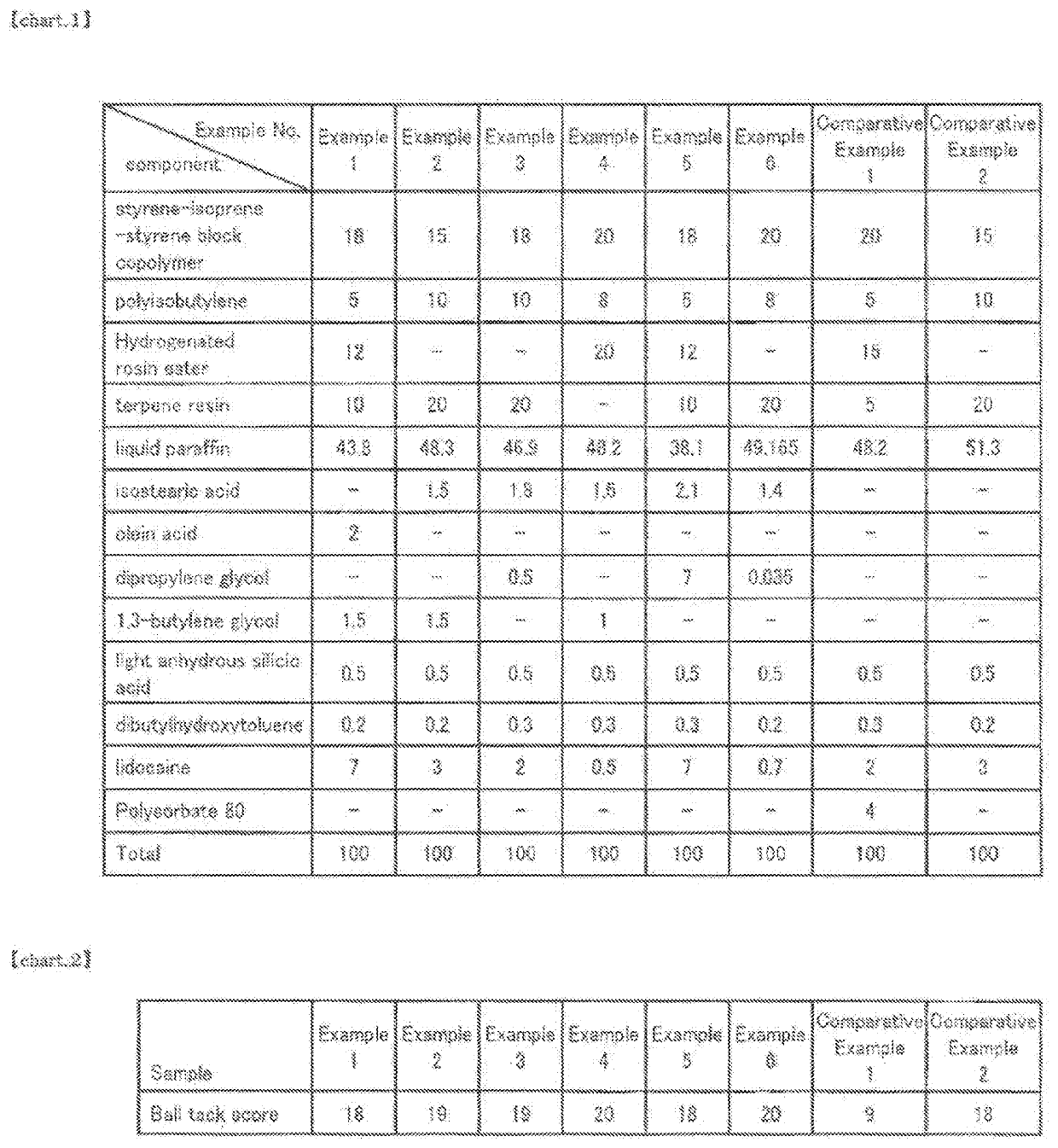Non-aqueous patch
a patch and non-aqueous technology, applied in the field of non-aqueous patches, can solve the problems of changing adhesion and physical properties, difficult to attach aqueous base patches to the skin for a long time, and poor compatibility of aqueous base patches with the skin, so as to achieve rapid increase in blood levels, efficiency and safety, and less side effects
- Summary
- Abstract
- Description
- Claims
- Application Information
AI Technical Summary
Benefits of technology
Problems solved by technology
Method used
Image
Examples
example 1
[0027]Styrene-isoprene-styrene block copolymer (“Kraton D1161”, produced by Kraton JSR Elastomers K.K.): 18 mass %
[0028]Polyisobutylene (trade name “Himol 6H”, produced by JX Nippon Oil & Energy Corporation): 5 mass %
[0029]Hydrogenated rosin ester (trade name “Pinecrystal KE-311”, produced by Arakawa Chemical Industries, Ltd.): 12 mass %
[0030]Terpene resin (trade name “YS resin 1150N”, produced by Yasuhara Chemical Co., Ltd.): 10 mass %
[0031]Lidocaine: 7 mass %
[0032]1,3-butylene glycol (produced by Daicel Chemical Industries, Ltd.): 1.5 mass %
[0033]Oleic acid (“Purified Oleic Acid”, produced by NOF Corporation): 2 mass %
[0034]Liquid paraffin (trade name “Hicall”, produced by Kaneda Corporation): 43.8 mass %
[0035]Light anhydrous silicic acid (trade name “Sylysia 350”, produced by Fuji Silysia Chemical Ltd.): 0.5 mass %
[0036]Dibutylhydroxytoluene (trade name “BHT”, produced by Honshu Chemical Industry Co., Ltd.): 0.2 mass %
[0037]The production method using these materials according to...
example 2
[0038]Styrene-isoprene-styrene block copolymer (“Kraton D1161”, produced by Kraton JSR Elastomers K.K.): 1.5 mass %
[0039]Polyisobutylene (trade name “Himol 6H”, produced by JX Nippon Oil & Energy Corporation): 10 mass %
[0040]Terpene resin (trade name “YS resin 1150N”, produced by Yasuhara Chemical Co., Ltd.): 20 mass %
[0041]Liquid paraffin (trade name “Hicall”, produced by Kaneda Corporation): 48.3 mass %
[0042]Isostearic acid (produced by Kokyu Alcohol Kogyo Co., Ltd.): 1.5 mass %
[0043]Lidocaine: 3 mass %
[0044]1,3-butylene glycol (produced by Daicel Chemical Industries, Ltd.): 1.5 mass %
[0045]Light anhydrous silicic acid (trade name “Sylysia 350”, produced by Fuji Silysia Chemical Ltd.): 0.5 mass %
[0046]Dibutylhydroxytoluene (trade name “BHT”, produced by Honshu Chemical Industry Co., Ltd.): 0.2 mass %
[0047]The production method using these materials according to the above formulation was as follows. The styrene-isoprene-styrene block copolymer, polyisobutylene, terpene resin, light...
example 3
[0048]Styrene-isoprene-styrene block copolymer (“Kraton D1161”, produced by Kraton JSR Elastomers K.K.): 18 mass %
[0049]Polyisobutylene (trade name “Himol 6H”, produced by JX Nippon Oil & Energy Corporation): 10 mass %
[0050]Terpene resin (trade name “YS resin 1150N”, produced by Yasuhara Chemical Co., Ltd.): 20 mass %
[0051]Liquid paraffin (trade name “Hicall”, produced by Kaneda Corporation): 46.9 mass %
[0052]Isostearic acid (produced by Kokyu Alcohol Kogyo Co., Ltd.): 1.8 mass %
[0053]Dipropylene glycol (produced by NOF Corporation): 0.5 mass %
[0054]Lidocaine: 2 mass %
[0055]Light anhydrous silicic acid (trade name “Sylysia 350”, produced by Fuji Silysia Chemical Ltd.): 0.5 mass %
[0056]Dibutylhydroxytoluene (trade name “BHT”, produced by Honshu Chemical Industry Co., Ltd.): 0.3 mass %
[0057]The production method using these materials according to the above formulation was as follows. The styrene-isoprene-styrene block copolymer, polyisobutylene, terpene resin, light anhydrous silicic ...
PUM
 Login to View More
Login to View More Abstract
Description
Claims
Application Information
 Login to View More
Login to View More - R&D
- Intellectual Property
- Life Sciences
- Materials
- Tech Scout
- Unparalleled Data Quality
- Higher Quality Content
- 60% Fewer Hallucinations
Browse by: Latest US Patents, China's latest patents, Technical Efficacy Thesaurus, Application Domain, Technology Topic, Popular Technical Reports.
© 2025 PatSnap. All rights reserved.Legal|Privacy policy|Modern Slavery Act Transparency Statement|Sitemap|About US| Contact US: help@patsnap.com


